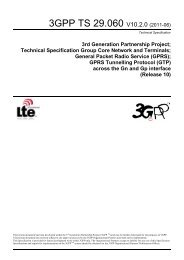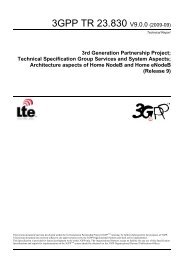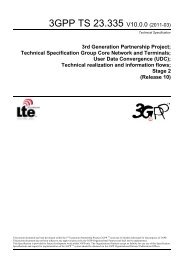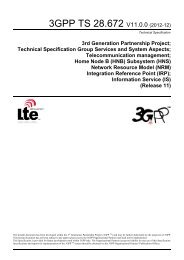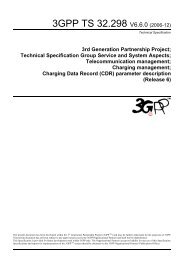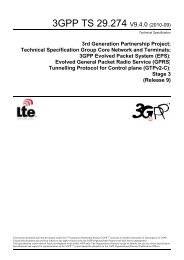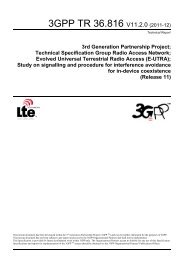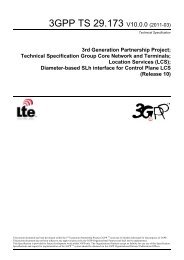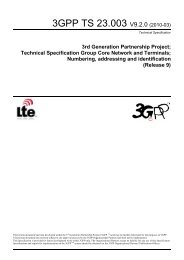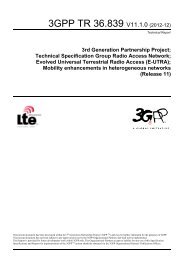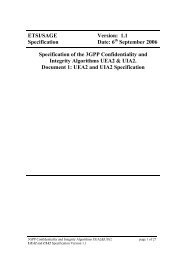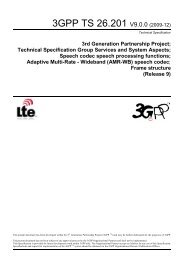ZUC Specification - GSMA
ZUC Specification - GSMA
ZUC Specification - GSMA
Create successful ePaper yourself
Turn your PDF publications into a flip-book with our unique Google optimized e-Paper software.
ETSI/SAGE<br />
<strong>Specification</strong><br />
Version: 1.6<br />
Date: 28 th June 2011<br />
<strong>Specification</strong> of the 3GPP Confidentiality and<br />
Integrity Algorithms 128-EEA3 & 128-EIA3.<br />
Document 2: <strong>ZUC</strong> <strong>Specification</strong><br />
The <strong>ZUC</strong> algorithm is the core of the<br />
standardised 3GPP Confidentiality and Integrity<br />
algorithms 128-EEA3 & 128-EIA3.<br />
3GPP Confidentiality and Integrity Algorithms 128-EEA3 & 128-EIA3. page 1 of 18<br />
<strong>ZUC</strong> Algorithm <strong>Specification</strong> Version 1.6
Document History<br />
1.0 18-06-2010 Publication<br />
1.2 26-07-2010 Improvements to C code<br />
1.3 27-07-2010 Minor corrections to C code<br />
1.4 30-07-2010 Corrected preface<br />
1.5 04-01-2011 A modification of <strong>ZUC</strong> in the initialization<br />
1.6 28-06-2011 Minor adjustment to C code<br />
3GPP Confidentiality and Integrity Algorithms 128-EEA3 & 128-EIA3. page 2 of 18<br />
<strong>ZUC</strong> Algorithm <strong>Specification</strong> Version 1.6
Blank Page<br />
3GPP Confidentiality and Integrity Algorithms 128-EEA3 & 128-EIA3. page 3 of 18<br />
<strong>ZUC</strong> Algorithm <strong>Specification</strong> Version 1.6
PREFACE<br />
This specification has been prepared by the 3GPP Task Force, and gives a detailed<br />
specification of the 3GPP algorithm <strong>ZUC</strong>. <strong>ZUC</strong> is a stream cipher that forms the heart of the<br />
3GPP confidentiality algorithm 128-EEA3 and the 3GPP integrity algorithm 128-EIA3. This<br />
document is the second of three, which between them form the entire specification of the<br />
3GPP Confidentiality and Integrity Algorithms:<br />
• <strong>Specification</strong> of the 3GPP Confidentiality and Integrity Algorithms 128-EEA3 &<br />
128-EIA3.<br />
Document 1: 128-EEA3 and 128-EIA3 <strong>Specification</strong>s.<br />
• <strong>Specification</strong> of the 3GPP Confidentiality and Integrity Algorithms 128-EEA3 &<br />
128-EIA3.<br />
Document 2: <strong>ZUC</strong> <strong>Specification</strong>.<br />
• <strong>Specification</strong> of the 3GPP Confidentiality and Integrity Algorithms 128-EEA3 &<br />
128-EIA3.<br />
Document 3: Implementor’s Test Data.<br />
The normative part of the specification of <strong>ZUC</strong> is in the main body of this document. Annex<br />
A, which is purely informative, contains an implementation program listing of the<br />
cryptographic algorithm specified in the main body of this document, written in the<br />
programming language C.<br />
3GPP Confidentiality and Integrity Algorithms 128-EEA3 & 128-EIA3. page 4 of 18<br />
<strong>ZUC</strong> Algorithm <strong>Specification</strong> Version 1.6
TABLE OF CONTENTS<br />
1 Introduction ........................................................................................................................7<br />
2 Notations and conventions..................................................................................................7<br />
2.1 Radix...........................................................................................................................7<br />
2.2 Bit ordering.................................................................................................................7<br />
2.3 Notations.....................................................................................................................7<br />
3 Algorithm description.........................................................................................................9<br />
3.1 General structure of the algorithm ..............................................................................9<br />
3.2 The linear feedback shift register (LFSR) ..................................................................9<br />
3.3 The Bit-reorganization..............................................................................................10<br />
3.4 The nonlinear function F ..........................................................................................11<br />
3.5 Key loading...............................................................................................................13<br />
3.6 The execution of <strong>ZUC</strong> ..............................................................................................14<br />
Appendix A: A C implementation of <strong>ZUC</strong> ..............................................................................15<br />
3GPP Confidentiality and Integrity Algorithms 128-EEA3 & 128-EIA3. page 5 of 18<br />
<strong>ZUC</strong> Algorithm <strong>Specification</strong> Version 1.6
NORMATIVE SECTION<br />
This part of the document contains the normative specification of the <strong>ZUC</strong> algorithm.<br />
3GPP Confidentiality and Integrity Algorithms 128-EEA3 & 128-EIA3. page 6 of 18<br />
<strong>ZUC</strong> Algorithm <strong>Specification</strong> Version 1.6
1 Introduction<br />
<strong>ZUC</strong> is a word-oriented stream cipher. It takes a 128-bit initial key and a 128-bit initial vector<br />
(IV) as input, and outputs a keystream of 32-bit words (where each 32-bit word is hence<br />
called a key-word). This keystream can be used for encryption/decryption.<br />
The execution of <strong>ZUC</strong> has two stages: initialization stage and working stage. In the first<br />
stage, a key/IV initialization is performed, i.e., the cipher is clocked without producing output<br />
(see section 3.6.1). The second stage is a working stage. In this stage, with every clock pulse,<br />
it produces a 32-bit word of output (see section 3.6.2).<br />
2 Notations and conventions<br />
2.1 Radix<br />
In this document, integers are represented as decimal numbers unless specified otherwise. We<br />
use the prefix “0x” to indicate hexadecimal numbers, and the subscript “2” to indicate a<br />
number in binary representation.<br />
Example 1<br />
Integer a can be written in different representations:<br />
a = 1234567890<br />
decimal representation<br />
= 0x499602D2 hexadecimal representation<br />
= 1001001100101100000001011010010 2 binary representation<br />
2.2 Bit ordering<br />
In this document, all data variables are presented with the most significant bit(byte) on the left<br />
hand side and the least significant bit(byte) on the right hand side.<br />
Example 2 Let a=1001001100101100000001011010010 2 . Then its most significant bit is<br />
1 (the leftmost bit) and its least significant bit is 0 (the rightmost bit).<br />
2.3 Notations<br />
+ The addition of two integers.<br />
ab The product of integers a and b.<br />
= The assignment operator.<br />
mod<br />
⊕<br />
The modulo operation of integers.<br />
The bit-wise exclusive-OR operation of integers.<br />
⊞ The modulo 2 32 addition .<br />
a || b The concatenation of strings a and b.<br />
3GPP Confidentiality and Integrity Algorithms 128-EEA3 & 128-EIA3. page 7 of 18<br />
<strong>ZUC</strong> Algorithm <strong>Specification</strong> Version 1.6
a H The leftmost 16 bits of integer a.<br />
a L The rightmost 16 bits of integer a.<br />
a 1 The l-bit right shift of integer a.<br />
(a 1 , a 2 ,…, a n )→ (b 1 , b 2 ,…, b n ) The assignment of the values of a i to b i in parallel.<br />
Example 3 For any two strings a and b, the presentation of string c created by the<br />
concatenation of a and b also follows the rules defined in section 2.2 i.e., the most significant<br />
digits are on the left hand side and the least significant digits are on the right hand side. For<br />
instance,<br />
Then we have<br />
a=0x1234,<br />
b=0x5678,<br />
c = a||b =0x12345678.<br />
Example 4<br />
Let<br />
a=1001001100101100000001011010010 2<br />
Then we have<br />
a H =1001001100101100 2 ,<br />
a L =0000001011010010 2 .<br />
Example 5<br />
Let<br />
a=11001001100101100000001011010010 2.<br />
Then we have<br />
a >> 1=1100100110010110000000101101001 2.<br />
Example 6<br />
Let a 0 , a 1 , …, a 15 , b 0 , b 1 , …, b 15 be all integer variables. Then<br />
(a 0 , a 1 , …, a 15 )→(b 0 , b 1 , …, b 15 )<br />
will result in b i =a i , 0≤ i≤ 15.<br />
3GPP Confidentiality and Integrity Algorithms 128-EEA3 & 128-EIA3. page 8 of 18<br />
<strong>ZUC</strong> Algorithm <strong>Specification</strong> Version 1.6
3 Algorithm description<br />
3.1 General structure of the algorithm<br />
<strong>ZUC</strong> has three logical layers, see Fig. 1. The top layer is a linear feedback shift register<br />
(LFSR) of 16 stages, the middle layer is for bit-reorganization ( BR), and the bottom layer is a<br />
nonlinear function F.<br />
Figure 1. General structure of <strong>ZUC</strong><br />
3.2 The linear feedback shift register (LFSR)<br />
The linear feedback shift register (LFSR) has 16 of 31-bit cells (s 0 , s 1 ,…, s 15 ). Each cell s i (0≤<br />
i≤ 15) is restricted to take values from the following set<br />
{1,2,3, …,2 31 – 1}.<br />
The LFSR has 2 modes of operations: the initialization mode and the working mode.<br />
In the initialization mode, the LFSR receives a 31-bit input word u, which is obtained by<br />
removing the rightmost bit from the 32-bit output W of the nonlinear function F, i.e.,<br />
u=W>>1. More specifically, the initialization mode works as follows:<br />
LFSRWithInitialisationMode(u)<br />
{<br />
1. v=2 15 s 15 +2 17 s 13 +2 21 s 10 +2 20 s 4 +(1+2 8 )s 0 mod (2 31 -1);<br />
3GPP Confidentiality and Integrity Algorithms 128-EEA3 & 128-EIA3. page 9 of 18<br />
<strong>ZUC</strong> Algorithm <strong>Specification</strong> Version 1.6
2. s 16 =(v+u) mod (2 31 -1);<br />
3. If s 16 =0, then set s 16 =2 31 -1;<br />
}<br />
4. (s 1 ,s 2 , …,s 15 ,s 16 )→ (s 0 ,s 1 , …,s 14 ,s 15 ).<br />
In the working mode, the LFSR does not receive any input, and it works as follows:<br />
LFSRWithWorkMode()<br />
{<br />
1. s 16 =2 15 s 15 +2 17 s 13 +2 21 s 10 +2 20 s 4 +(1+2 8 )s 0 mod (2 31 -1);<br />
2. If s 16 =0, then set s 16 =2 31 -1;<br />
}<br />
3. (s 1 ,s 2 , …,s 15 ,s 16 )→ (s 0 ,s 1 , …,s 14 ,s 15 ).<br />
Informative note: Since the multiplication of a 31-bit string s by 2 i over GF(2 31 -1) can be<br />
implemented by a cyclic shift of s to the left by i bits, only addition modulo 2 31 -1 is needed in<br />
step 1 of the above functions. More precisely, step 1 of the function<br />
LFSRWithInitialisationMode can be implemented by<br />
v=(s 15
Note: The s i are 31-bit integers, so s iH means bits 30...15 and not 31...16 of s i , for 0≤ i≤ 15.<br />
3.4 The nonlinear function F<br />
The nonlinear function F has 2 of 32-bit memory cells R 1 and R 2 . Let the inputs to F be X 0 , X 1<br />
and X 2 , which come from the outputs of the bit-reorganization (see section 3.3), then the<br />
function F outputs a 32-bit word W. The detailed process of F is as follows:<br />
F (X 0 , X 1 , X 2 )<br />
{<br />
1. W=( X 0 ⊕ R 1 ) ⊞ R 2 ;<br />
2. W 1 = R 1 ⊞X 1 ;<br />
3. W 2 = R 2 ⊕ X 2 ;<br />
}<br />
4. R 1 =S(L 1 (W 1L ||W 2H ));<br />
5. R 2 =S(L 2 (W 2L ||W 1H )).<br />
where S is a 32×32 S-box, see section 3.4.1, L 1 and L 2 are linear transforms as defined in<br />
section 3.4.2.<br />
3.4.1 The S-box S<br />
The 32×32 S-box S is composed of 4 juxtaposed 8×8 S-boxes, i.e., S=(S 0 ,S 1 ,S 2 ,S 3 ), where<br />
S 0 =S 2 , S 1 =S 3 . The definitions of S 0 and S 1 can be found in table 3.1 and table 3.2 respectively.<br />
Let x be an 8-bit input to S 0 (or S 1 ). Write x into two hexadecimal digits as x=h||l, then the<br />
entry at the intersection of the h-th row and the l-th column in table 3.1 (or table 3.2) is the<br />
output of S 0 (or S 1 ).<br />
Example 7<br />
S 0 (0x12)=0xF9 and S 1 (0x34)=0xC0.<br />
Let the 32-bit input X and the 32-bit output Y of the S-box S be as follows:<br />
X = x 0 || x 1 || x 2 || x 3 ,<br />
Y = y 0 || y 1 || y 2 || y 3 ,<br />
where x i and y i are all bytes, i=0,1,2,3. Then we have<br />
y i =S i (x i ), i=0,1,2,3.<br />
Example 8<br />
we have<br />
Let X=0x12345678 be a 32-bit input to the S-box and Y its 32-bit output. Then<br />
Y=S(X)=S 0 (0x12)||S 1 (0x34)||S 2 (0x56)||S 3 (0x78)=0xF9C05A4E.<br />
3GPP Confidentiality and Integrity Algorithms 128-EEA3 & 128-EIA3. page 11 of 18<br />
<strong>ZUC</strong> Algorithm <strong>Specification</strong> Version 1.6
Table 3.1. The S-box S 0<br />
0 1 2 3 4 5 6 7 8 9 A B C D E F<br />
0 3E 72 5B 47 CA E0 00 33 04 D1 54 98 09 B9 6D CB<br />
1 7B 1B F9 32 AF 9D 6A A5 B8 2D FC 1D 08 53 03 90<br />
2 4D 4E 84 99 E4 CE D9 91 DD B6 85 48 8B 29 6E AC<br />
3 CD C1 F8 1E 73 43 69 C6 B5 BD FD 39 63 20 D4 38<br />
4 76 7D B2 A7 CF ED 57 C5 F3 2C BB 14 21 06 55 9B<br />
5 E3 EF 5E 31 4F 7F 5A A4 0D 82 51 49 5F BA 58 1C<br />
6 4A 16 D5 17 A8 92 24 1F 8C FF D8 AE 2E 01 D3 AD<br />
7 3B 4B DA 46 EB C9 DE 9A 8F 87 D7 3A 80 6F 2F C8<br />
8 B1 B4 37 F7 0A 22 13 28 7C CC 3C 89 C7 C3 96 56<br />
9 07 BF 7E F0 0B 2B 97 52 35 41 79 61 A6 4C 10 FE<br />
A BC 26 95 88 8A B0 A3 FB C0 18 94 F2 E1 E5 E9 5D<br />
B D0 DC 11 66 64 5C EC 59 42 75 12 F5 74 9C AA 23<br />
C 0E 86 AB BE 2A 02 E7 67 E6 44 A2 6C C2 93 9F F1<br />
D F6 FA 36 D2 50 68 9E 62 71 15 3D D6 40 C4 E2 0F<br />
E 8E 83 77 6B 25 05 3F 0C 30 EA 70 B7 A1 E8 A9 65<br />
F 8D 27 1A DB 81 B3 A0 F4 45 7A 19 DF EE 78 34 60<br />
Table 3.2. The S-box S 1<br />
0 1 2 3 4 5 6 7 8 9 A B C D E F<br />
0 55 C2 63 71 3B C8 47 86 9F 3C DA 5B 29 AA FD 77<br />
1 8C C5 94 0C A6 1A 13 00 E3 A8 16 72 40 F9 F8 42<br />
2 44 26 68 96 81 D9 45 3E 10 76 C6 A7 8B 39 43 E1<br />
3 3A B5 56 2A C0 6D B3 05 22 66 BF DC 0B FA 62 48<br />
4 DD 20 11 06 36 C9 C1 CF F6 27 52 BB 69 F5 D4 87<br />
5 7F 84 4C D2 9C 57 A4 BC 4F 9A DF FE D6 8D 7A EB<br />
6 2B 53 D8 5C A1 14 17 FB 23 D5 7D 30 67 73 08 09<br />
7 EE B7 70 3F 61 B2 19 8E 4E E5 4B 93 8F 5D DB A9<br />
8 AD F1 AE 2E CB 0D FC F4 2D 46 6E 1D 97 E8 D1 E9<br />
9 4D 37 A5 75 5E 83 9E AB 82 9D B9 1C E0 CD 49 89<br />
A 01 B6 BD 58 24 A2 5F 38 78 99 15 90 50 B8 95 E4<br />
B D0 91 C7 CE ED 0F B4 6F A0 CC F0 02 4A 79 C3 DE<br />
C A3 EF EA 51 E6 6B 18 EC 1B 2C 80 F7 74 E7 FF 21<br />
D 5A 6A 54 1E 41 31 92 35 C4 33 07 0A BA 7E 0E 34<br />
E 88 B1 98 7C F3 3D 60 6C 7B CA D3 1F 32 65 04 28<br />
F 64 BE 85 9B 2F 59 8A D7 B0 25 AC AF 12 03 E2 F2<br />
Note: The entries in the above S-boxes S 0 and S 1 are all in hexadecimal representation.<br />
3GPP Confidentiality and Integrity Algorithms 128-EEA3 & 128-EIA3. page 12 of 18<br />
<strong>ZUC</strong> Algorithm <strong>Specification</strong> Version 1.6
3.4.2 The linear transforms L 1 and L 2<br />
Both L 1 and L 2 are linear transforms from 32-bit words to 32-bit words, and are defined as<br />
follows:<br />
L 1 (X)=X⊕ (X
d 12 = 101111000100110 2 ,<br />
d 13 = 011110001001101 2 ,<br />
d 14 = 111100010011010 2 ,<br />
d 15 = 100011110101100 2 .<br />
2. For 0≤ i≤ 15, let s i =k i ||d i ||iv i .<br />
3.6 The execution of <strong>ZUC</strong><br />
The execution of <strong>ZUC</strong> has two stages: the initialization stage and the working stage.<br />
3.6.1 The initialization stage<br />
During the initialization stage, the algorithm calls the key loading procedure (see section 3.5)<br />
to load the 128-bit initial key k and the 128-bit initial vector iv into the LFSR, and set the 32-<br />
bit memory cells R 1 and R 2 to be all 0. Then the cipher runs the following operations 32 times:<br />
1. Bitreorganization(); // see section 3.3<br />
2. w=F(X 0 , X 1 , X 2 ); // see section 3.4<br />
3. LFSRWithInitialisationMode(w>>1). // see section 3.2<br />
3.6.2 The working stage<br />
After the initialization stage, the algorithm moves into the working stage. At the working<br />
stage, the algorithm executes the following operations once, and discards the output W of F:<br />
1. Bitreorganization(); // see section 3.3<br />
2. F(X 0 , X 1 , X 2 ); //output discarded, see section 3.4<br />
3. LFSRWithWorkMode(). // see section 3.2<br />
Then the algorithm goes into the stage of producing keystream, i.e., for each iteration, the<br />
following operations are executed once, and a 32-bit word Z is produced as an output:<br />
1. Bitreorganization(); // see section 3.3<br />
2. Z= F(X 0 , X 1 , X 2 )⊕ X 3 ; // for the definition of X 3 , see section 3.3<br />
3. LFSRWithWorkMode() . // see section 3.2<br />
3GPP Confidentiality and Integrity Algorithms 128-EEA3 & 128-EIA3. page 14 of 18<br />
<strong>ZUC</strong> Algorithm <strong>Specification</strong> Version 1.6
Appendix A: A C implementation of <strong>ZUC</strong><br />
/* ——————————————————————- */<br />
typedef unsigned char u8;<br />
typedef unsigned int u32;<br />
/* ——————————————————————- */<br />
/* the state registers of LFSR */<br />
u32 LFSR_S0;<br />
u32 LFSR_S1;<br />
u32 LFSR_S2;<br />
u32 LFSR_S3;<br />
u32 LFSR_S4;<br />
u32 LFSR_S5;<br />
u32 LFSR_S6;<br />
u32 LFSR_S7;<br />
u32 LFSR_S8;<br />
u32 LFSR_S9;<br />
u32 LFSR_S10;<br />
u32 LFSR_S11;<br />
u32 LFSR_S12;<br />
u32 LFSR_S13;<br />
u32 LFSR_S14;<br />
u32 LFSR_S15;<br />
/* the registers of F */<br />
u32 F_R1;<br />
u32 F_R2;<br />
/* the outputs of BitReorganization */<br />
u32 BRC_X0;<br />
u32 BRC_X1;<br />
u32 BRC_X2;<br />
u32 BRC_X3;<br />
/* the s-boxes */<br />
u8 S0[256] = {<br />
0x3e,0x72,0x5b,0x47,0xca,0xe0,0x00,0x33,0x04,0xd1,0x54,0x98,0x09,0xb9,0x6d,0xcb,<br />
0x7b,0x1b,0xf9,0x32,0xaf,0x9d,0x6a,0xa5,0xb8,0x2d,0xfc,0x1d,0x08,0x53,0x03,0x90,<br />
0x4d,0x4e,0x84,0x99,0xe4,0xce,0xd9,0x91,0xdd,0xb6,0x85,0x48,0x8b,0x29,0x6e,0xac,<br />
0xcd,0xc1,0xf8,0x1e,0x73,0x43,0x69,0xc6,0xb5,0xbd,0xfd,0x39,0x63,0x20,0xd4,0x38,<br />
0x76,0x7d,0xb2,0xa7,0xcf,0xed,0x57,0xc5,0xf3,0x2c,0xbb,0x14,0x21,0x06,0x55,0x9b,<br />
0xe3,0xef,0x5e,0x31,0x4f,0x7f,0x5a,0xa4,0x0d,0x82,0x51,0x49,0x5f,0xba,0x58,0x1c,<br />
0x4a,0x16,0xd5,0x17,0xa8,0x92,0x24,0x1f,0x8c,0xff,0xd8,0xae,0x2e,0x01,0xd3,0xad,<br />
0x3b,0x4b,0xda,0x46,0xeb,0xc9,0xde,0x9a,0x8f,0x87,0xd7,0x3a,0x80,0x6f,0x2f,0xc8,<br />
0xb1,0xb4,0x37,0xf7,0x0a,0x22,0x13,0x28,0x7c,0xcc,0x3c,0x89,0xc7,0xc3,0x96,0x56,<br />
0x07,0xbf,0x7e,0xf0,0x0b,0x2b,0x97,0x52,0x35,0x41,0x79,0x61,0xa6,0x4c,0x10,0xfe,<br />
0xbc,0x26,0x95,0x88,0x8a,0xb0,0xa3,0xfb,0xc0,0x18,0x94,0xf2,0xe1,0xe5,0xe9,0x5d,<br />
0xd0,0xdc,0x11,0x66,0x64,0x5c,0xec,0x59,0x42,0x75,0x12,0xf5,0x74,0x9c,0xaa,0x23,<br />
0x0e,0x86,0xab,0xbe,0x2a,0x02,0xe7,0x67,0xe6,0x44,0xa2,0x6c,0xc2,0x93,0x9f,0xf1,<br />
0xf6,0xfa,0x36,0xd2,0x50,0x68,0x9e,0x62,0x71,0x15,0x3d,0xd6,0x40,0xc4,0xe2,0x0f,<br />
0x8e,0x83,0x77,0x6b,0x25,0x05,0x3f,0x0c,0x30,0xea,0x70,0xb7,0xa1,0xe8,0xa9,0x65,<br />
0x8d,0x27,0x1a,0xdb,0x81,0xb3,0xa0,0xf4,0x45,0x7a,0x19,0xdf,0xee,0x78,0x34,0x60<br />
};<br />
u8 S1[256] = {<br />
0x55,0xc2,0x63,0x71,0x3b,0xc8,0x47,0x86,0x9f,0x3c,0xda,0x5b,0x29,0xaa,0xfd,0x77,<br />
0x8c,0xc5,0x94,0x0c,0xa6,0x1a,0x13,0x00,0xe3,0xa8,0x16,0x72,0x40,0xf9,0xf8,0x42,<br />
0x44,0x26,0x68,0x96,0x81,0xd9,0x45,0x3e,0x10,0x76,0xc6,0xa7,0x8b,0x39,0x43,0xe1,<br />
0x3a,0xb5,0x56,0x2a,0xc0,0x6d,0xb3,0x05,0x22,0x66,0xbf,0xdc,0x0b,0xfa,0x62,0x48,<br />
0xdd,0x20,0x11,0x06,0x36,0xc9,0xc1,0xcf,0xf6,0x27,0x52,0xbb,0x69,0xf5,0xd4,0x87,<br />
0x7f,0x84,0x4c,0xd2,0x9c,0x57,0xa4,0xbc,0x4f,0x9a,0xdf,0xfe,0xd6,0x8d,0x7a,0xeb,<br />
0x2b,0x53,0xd8,0x5c,0xa1,0x14,0x17,0xfb,0x23,0xd5,0x7d,0x30,0x67,0x73,0x08,0x09,<br />
0xee,0xb7,0x70,0x3f,0x61,0xb2,0x19,0x8e,0x4e,0xe5,0x4b,0x93,0x8f,0x5d,0xdb,0xa9,<br />
0xad,0xf1,0xae,0x2e,0xcb,0x0d,0xfc,0xf4,0x2d,0x46,0x6e,0x1d,0x97,0xe8,0xd1,0xe9,<br />
0x4d,0x37,0xa5,0x75,0x5e,0x83,0x9e,0xab,0x82,0x9d,0xb9,0x1c,0xe0,0xcd,0x49,0x89,<br />
0x01,0xb6,0xbd,0x58,0x24,0xa2,0x5f,0x38,0x78,0x99,0x15,0x90,0x50,0xb8,0x95,0xe4,<br />
0xd0,0x91,0xc7,0xce,0xed,0x0f,0xb4,0x6f,0xa0,0xcc,0xf0,0x02,0x4a,0x79,0xc3,0xde,<br />
0xa3,0xef,0xea,0x51,0xe6,0x6b,0x18,0xec,0x1b,0x2c,0x80,0xf7,0x74,0xe7,0xff,0x21,<br />
0x5a,0x6a,0x54,0x1e,0x41,0x31,0x92,0x35,0xc4,0x33,0x07,0x0a,0xba,0x7e,0x0e,0x34,<br />
0x88,0xb1,0x98,0x7c,0xf3,0x3d,0x60,0x6c,0x7b,0xca,0xd3,0x1f,0x32,0x65,0x04,0x28,<br />
0x64,0xbe,0x85,0x9b,0x2f,0x59,0x8a,0xd7,0xb0,0x25,0xac,0xaf,0x12,0x03,0xe2,0xf2<br />
};<br />
/* the constants D */<br />
u32 EK_d[16] = {<br />
0x44D7, 0x26BC, 0x626B, 0x135E, 0x5789, 0x35E2, 0x7135, 0x09AF,<br />
0x4D78, 0x2F13, 0x6BC4, 0x1AF1, 0x5E26, 0x3C4D, 0x789A, 0x47AC<br />
};<br />
3GPP Confidentiality and Integrity Algorithms 128-EEA3 & 128-EIA3. page 15 of 18<br />
<strong>ZUC</strong> Algorithm <strong>Specification</strong> Version 1.6
* ——————————————————————- */<br />
/* c = a + b mod (2^31 – 1) */<br />
u32 AddM(u32 a, u32 b)<br />
{<br />
u32 c = a + b;<br />
return (c & 0x7FFFFFFF) + (c >> 31);<br />
}<br />
/* LFSR with initialization mode */<br />
#define MulByPow2(x, k) ((((x) > (31 - k))) & 0x7FFFFFFF)<br />
void LFSRWithInitialisationMode(u32 u)<br />
{<br />
u32 f, v;<br />
f = LFSR_S0;<br />
v = MulByPow2(LFSR_S0, 8);<br />
f = AddM(f, v);<br />
v = MulByPow2(LFSR_S4, 20);<br />
f = AddM(f, v);<br />
v = MulByPow2(LFSR_S10, 21);<br />
f = AddM(f, v);<br />
v = MulByPow2(LFSR_S13, 17);<br />
f = AddM(f, v);<br />
v = MulByPow2(LFSR_S15, 15);<br />
f = AddM(f, v);<br />
f = AddM(f, u);<br />
}<br />
/* update the state */<br />
LFSR_S0 = LFSR_S1;<br />
LFSR_S1 = LFSR_S2;<br />
LFSR_S2 = LFSR_S3;<br />
LFSR_S3 = LFSR_S4;<br />
LFSR_S4 = LFSR_S5;<br />
LFSR_S5 = LFSR_S6;<br />
LFSR_S6 = LFSR_S7;<br />
LFSR_S7 = LFSR_S8;<br />
LFSR_S8 = LFSR_S9;<br />
LFSR_S9 = LFSR_S10;<br />
LFSR_S10 = LFSR_S11;<br />
LFSR_S11 = LFSR_S12;<br />
LFSR_S12 = LFSR_S13;<br />
LFSR_S13 = LFSR_S14;<br />
LFSR_S14 = LFSR_S15;<br />
LFSR_S15 = f;<br />
/* LFSR with work mode */<br />
void LFSRWithWorkMode()<br />
{<br />
u32 f, v;<br />
f = LFSR_S0;<br />
v = MulByPow2(LFSR_S0, 8);<br />
f = AddM(f, v);<br />
v = MulByPow2(LFSR_S4, 20);<br />
f = AddM(f, v);<br />
v = MulByPow2(LFSR_S10, 21);<br />
f = AddM(f, v);<br />
v = MulByPow2(LFSR_S13, 17);<br />
f = AddM(f, v);<br />
v = MulByPow2(LFSR_S15, 15);<br />
f = AddM(f, v);<br />
/* update the state */<br />
LFSR_S0 = LFSR_S1;<br />
LFSR_S1 = LFSR_S2;<br />
LFSR_S2 = LFSR_S3;<br />
LFSR_S3 = LFSR_S4;<br />
3GPP Confidentiality and Integrity Algorithms 128-EEA3 & 128-EIA3. page 16 of 18<br />
<strong>ZUC</strong> Algorithm <strong>Specification</strong> Version 1.6
}<br />
LFSR_S4 = LFSR_S5;<br />
LFSR_S5 = LFSR_S6;<br />
LFSR_S6 = LFSR_S7;<br />
LFSR_S7 = LFSR_S8;<br />
LFSR_S8 = LFSR_S9;<br />
LFSR_S9 = LFSR_S10;<br />
LFSR_S10 = LFSR_S11;<br />
LFSR_S11 = LFSR_S12;<br />
LFSR_S12 = LFSR_S13;<br />
LFSR_S13 = LFSR_S14;<br />
LFSR_S14 = LFSR_S15;<br />
LFSR_S15 = f;<br />
/* BitReorganization */<br />
void BitReorganization()<br />
{<br />
BRC_X0 = ((LFSR_S15 & 0x7FFF8000) 15);<br />
BRC_X2 = ((LFSR_S7 & 0xFFFF) > 15);<br />
BRC_X3 = ((LFSR_S2 & 0xFFFF) > 15);<br />
}<br />
#define ROT(a, k) (((a) > (32 - k)))<br />
/* L1 */<br />
u32 L1(u32 X)<br />
{<br />
return (X ^ ROT(X, 2) ^ ROT(X, 10) ^ ROT(X, 18) ^ ROT(X, 24));<br />
}<br />
/* L2 */<br />
u32 L2(u32 X)<br />
{<br />
return (X ^ ROT(X, 8) ^ ROT(X, 14) ^ ROT(X, 22) ^ ROT(X, 30));<br />
}<br />
#define MAKEU32(a, b, c, d) (((u32)(a) > 24], S1[(u >> 16) & 0xFF],<br />
S0[(u >> 8) & 0xFF], S1[u & 0xFF]);<br />
F_R2 = MAKEU32(S0[v >> 24], S1[(v >> 16) & 0xFF],<br />
S0[(v >> 8) & 0xFF], S1[v & 0xFF]);<br />
return W;<br />
}<br />
#define MAKEU31(a, b, c) (((u32)(a)
LFSR_S14 = MAKEU31(k[14], EK_d[14], iv[14]);<br />
LFSR_S15 = MAKEU31(k[15], EK_d[15], iv[15]);<br />
}<br />
/* set F_R1 and F_R2 to zero */<br />
F_R1 = 0;<br />
F_R2 = 0;<br />
nCount = 32;<br />
while (nCount > 0)<br />
{<br />
BitReorganization();<br />
w = F();<br />
LFSRWithInitialisationMode(w >> 1);<br />
nCount --;<br />
}<br />
void GenerateKeystream(u32* pKeystream, int KeystreamLen)<br />
{<br />
int i;<br />
{<br />
}<br />
BitReorganization();<br />
F(); /* discard the output of F */<br />
LFSRWithWorkMode();<br />
}<br />
for (i = 0; i < KeystreamLen; i ++)<br />
{<br />
BitReorganization();<br />
pKeystream[i] = F() ^ BRC_X3;<br />
LFSRWithWorkMode();<br />
}<br />
3GPP Confidentiality and Integrity Algorithms 128-EEA3 & 128-EIA3. page 18 of 18<br />
<strong>ZUC</strong> Algorithm <strong>Specification</strong> Version 1.6



